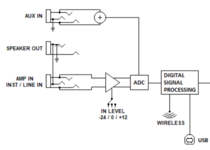You are using an out of date browser. It may not display this or other websites correctly.
You should upgrade or use an alternative browser.
You should upgrade or use an alternative browser.
Cab M+ with Resistive vs Reactive Load
- Thread starter cpiz88
- Start date
If you connect speaker out from amp to Cab M+ and then to load box, does it matter if the load is resistive or reactive in regards to tone and feel?
Reactive is way better in my experience. Resistive loads are static - a reactive load is going to change
impedance based on the signal - just like a speaker does.
Does it matter if that signal is captured from the speaker out before it hits the load box?
Amp speaker out > CAB M amp in
Cab M Speaker out > load box in
Correct, so in that signal flow since the load box is after the Cab M+ does it matter if that load box is resistive or reactive in respect to tone and feel?
AHHHHHHH, now I got it.
I would think if you are adding an IR via the Cab-M and only using its line out signal it wouldn't matter.
If you plan on doing anything with the line out from the load box then I'd go reactive.
I have never tried either of these specific setups with the Cab-M so I'm not certain.
Thanks Donnie, I do this set up with my Cab M+ and Mesa Cab Clone which is resistive. I'm just trying to figure out if getting a reactive load box in this scenario is worth it as the signal is captured before it hits the load box. Who am I kidding, I'll probably end up getting one either way.
The Cab M+ is before the resistive load so that's why I was wondering if it made a difference.That's a good question! My opinion is it does matter because the amp will react different on the resistive load so what the CABM+ picks up from that signal will be different.
That makes sense.The amp and load interact with or without the CABM+ between them. So putting the CABM+ between them means the the signal the CABM+ sees is the amp <-> resistive load interaction. I think that would be different than connected to a reactive load.
The amp and load interact with or without the CABM+ between them.
My understanding was that routing the amp line out taken from the speaker out
thru the Cab's internal speaker sim separated the signal from the impedance
fluctuations of the load.
Again, not certain at all.
It appears to just take the signal off the amp <>speaker path so I think if that signal was amp <> resistive load it probably wouldn't be as good as amp <> reactive load like you pointed out earlier.
Again, maybe but I'd wager that once the analog signal is converted to digital the DSP takes over
and keeps the signal steady.
Otherwise IRs would be all over the place.
The dozens of possible loads would defeat their purpose.
Anyone know what's under the hood?
Kapo_Polenton
Well-known member
Interesting enough, I brought this up in a thread a week ago. My thoughts is that tapping it this way should minimize the effect of the load on the tone but someone explained that it very well might still impact the way the amp pushes out. The load almost pushes back so it might very well affect things more than you think and that is why at the very least, a good reactive load should be used. I would like to see a test doing this though. resistive and then 3 different reactive loads to see if there really is a diff.

